Welcome to the EGGhead Forum - a great place to visit and packed with tips and EGGspert advice! You can also join the conversation and get more information and amazing kamado recipes by following Big Green Egg to Experience our World of Flavor™ at:
Want to see how the EGG is made? Click to Watch
Facebook | Twitter | Instagram | Pinterest | Youtube | Vimeo
Share your photos by tagging us and using the hashtag #BigGreenEgg.
Share your photos by tagging us and using the hashtag #BigGreenEgg.
Want to see how the EGG is made? Click to Watch
Suggestions
Options

Susan Egglaine
Posts: 2,437
Bought this today for the bone (to put in beans) Should I slow smoke it tonight, put it in the crockpot with beans or whole thing, beans on BGE. Any suggestions? 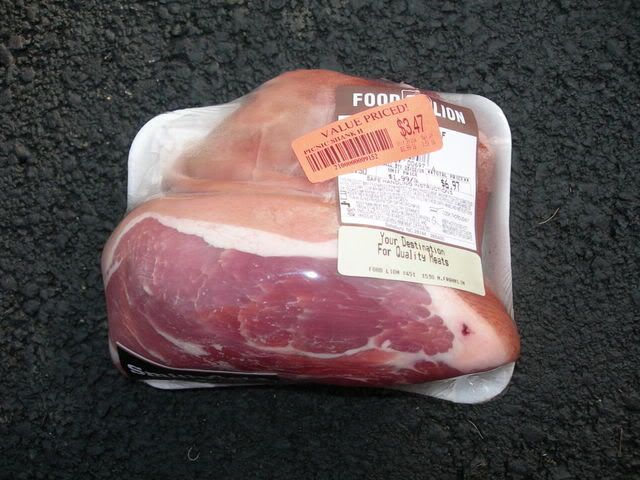 THANKS!!!!
THANKS!!!!
 THANKS!!!!
THANKS!!!! Comments
-
smoke it tonight , you asked and i just got back from the store where they had smoked ham hocks.
-
Susan,
That is one nice shank. I would smoke it whole then add to a big pot of beans when you start them. After several hours it will be tender enough to remove the bone and gristle and shred the meat.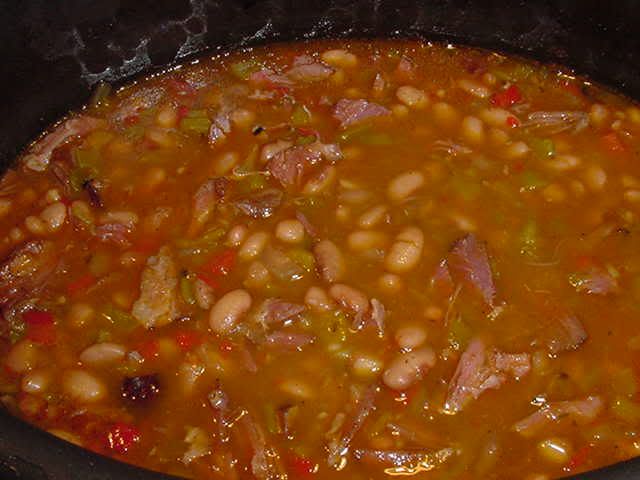
In the PORK section of my site is a page devoted to hocks, shanks etc. It covers some techniques for smoking with and without brining first.
In the SIDE DISH section are several recipes for cooking beans from scratch, they all use either hocks or shanks. Both pinto and Great Northern beans are featured so maybe these will give you some ideas.
Click the link in the signature box below then on my homepage, scroll down for the recipe section.
I've gotten several e-mails today saying Google is having some delays in the servers, you may have to try the link a couple of times to get through.Happy Trails~thirdeye~Barbecue is not rocket surgery -
About how long or at what internal temp should I smoke ?
-
Susan,
I guess my instructions were for much smaller ones weren't they? Okay, the same pit temps will apply, but I would go with the upper end and use 250° at the grate, which is about 275° or so measured on your dome thermometer. Use an indirect set-up.
Like the how-to mentions, a 160°-170° internal temp is what you are after because the shank will be simmering along with the beans. It will be fall-apart tender before the beans are done. I'm guessing you have a 3 pound shank? So, I would think that 3 to 5 hours would get it to that 160/170 internal. Just don't rush it. That amount of time will also get some nice smoke flavor also.
It doesen't sound like you have the time to brine it, so maybe try that next time. Like I mentioned, also try a second smoke on store-bought hocks or shanks, they are good too.Happy Trails~thirdeye~Barbecue is not rocket surgery -
Hey Bill,
A second or "wake-up" smoke on the store-bought smoked hocks really works well. An hour or two will make a big flavor difference.Happy Trails~thirdeye~Barbecue is not rocket surgery -
i figured that out with smoked butts. bringing them up to temp with a second smoke sliced with some mustard. wow. you made mention a while back about wet pastrami care to elaborate, as you know my first attempt was amazing . and i followed your directions thank you .
-
Bill,
I need to update my pastrami page. I mention smoking until 150° then finishing in foil with some liquid for "wet" pastrami. This is a good method, but I have taken it one step further.....Everything in the original technique is the same and I still smoke it until 150°, but instead of foil I have been doing a pressure finish for 20 minutes (with a natural release). The finished product is closer to olde style deli pastrami that has been steamed. Very flavorful and very tender. This is a 4 pound piece and I used 3 cups of water. The bark is soft after coming out of the cooker but it sets up when the pastrami is cooled. We have been enjoying it as a main meat for the evening meal (along with potatoes, cabbage or other veggies) then using the leftover for sandwiches.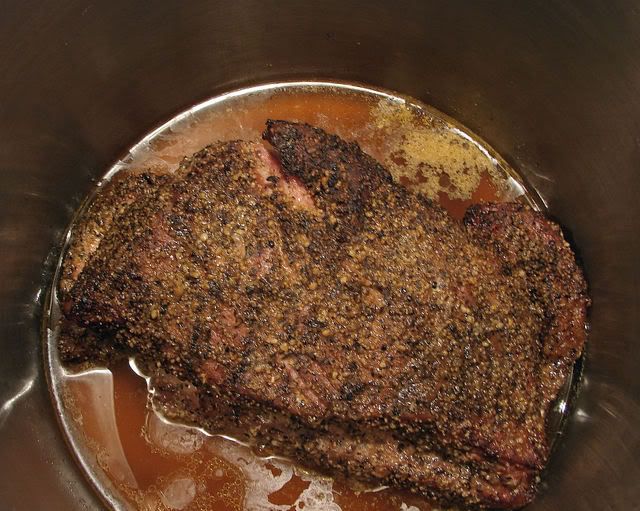
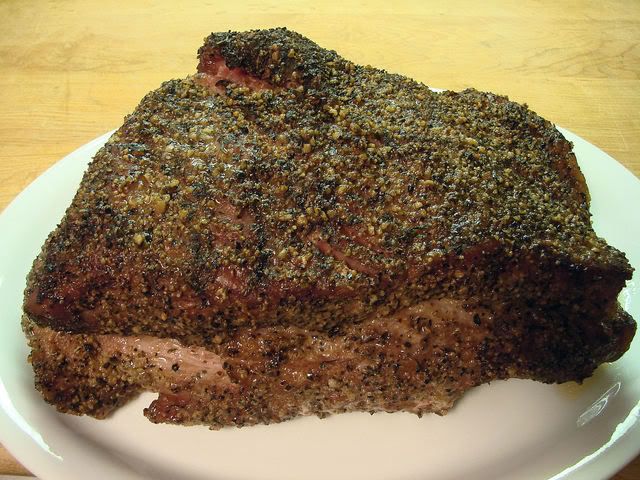
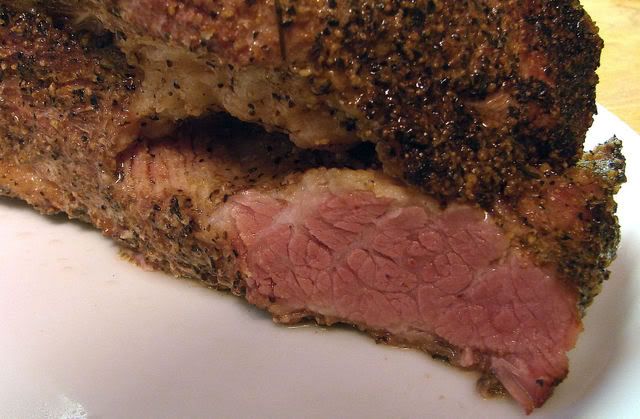 Happy Trails~thirdeye~Barbecue is not rocket surgery
Happy Trails~thirdeye~Barbecue is not rocket surgery -
You guys rock!! I guess I will have to add pastrami to the list. Thanks for all you help! :cheer:
-
Thirdeye,
'instead of foil I have been doing a pressure finish for 20 minutes (with a natural release).'
My eye caught the pastami, Boy oh boy does that piece look fantastic.
Are you using a pressure cooker? What is a natural release?
I am lost after the 150° part.
Kent -
Susan,
Don't take long, thirdeye's Pastrami is unbelievable a real egg must.
Besides many of the obvious pastrami dishes, we have cooked burgers then sliced the pastrami thin and made huge pastrami burgers.
The dry Pastrami is good but the wet is just something else. I really want to try this new method he is talking about.
GG -
Yeah Kent, a pressure cooker. It takes the internal temperature up 40° in the 20 minutes of cook time. From 150° internal to 190° internal. It also locks in the flavors and moisture and gives a steaming effect because there is some water added to the pot. The meat still needs to rest as usual, so I transfer it into foil for that.
There are two ways to time pressure cooking. One is using a quick release. This involves cooling the cooker under a light stream of water in the sink. It is helpful if you want to interrupt cooking to say, add some veggies or potatoes to a roast or chicken. It takes a couple of minutes to bring the pressure down, then you open the cooker, add whatever, close it up and you are back up to pressure in a few more minutes.
The second method of timing is natural release. At the end of your cook time, you just remove the cooker from the burner, and (depending on the load)it takes maybe 10 minutes for the pressure to drop. Longer for a full load. During this 10 minutes, the product is still cooking somewhat.
Here are come country (shoulder) ribs that I season and pull for my tamale filling. You can see how the meat is ready to fall off the blade bone. Pressure cookers make fantastic broth because nothing is lost to the air, and I use broth when preparing the meat for tamales. I can cook the pork in an 45 minutes instead of 3 or 4 hours of braising.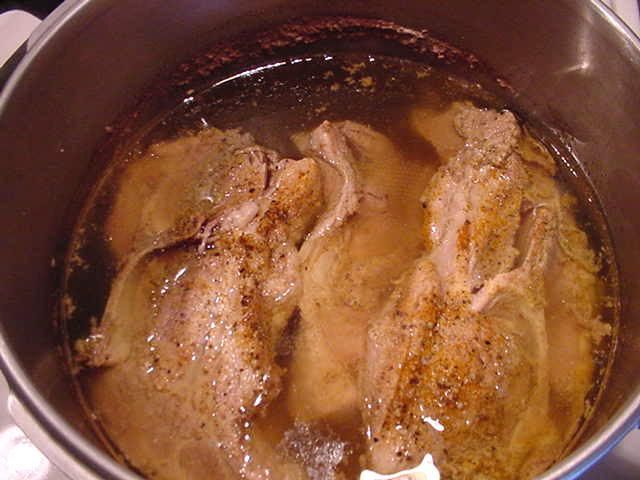
Do you own a pressure cooker?Happy Trails~thirdeye~Barbecue is not rocket surgery -
I followed your pastrami recipe today. It was
great. The wife and kids loved it. I used the
old procedure and it was still terrific. I soaked
the brisket I got at Kroger for 48 hours and the
amount of saltiness was just right. -
Wayne,
I have 3, two of which are Kuhn Rikon Duromatic. All have a valve which releases when the pressure builds up too high. I am pretty sure I have to pull the valve to force release the pressure before opening on the different cookers I have.
There are two red lines on the pressure valve, if I recall the first is 5 (or 7# ) the second line is 10# (or 15#) .
There is going to be no way to test the meat temp, this will all have to be by guess.
It looks like you are adding enough water to cover the pastrami about 1/2 of its thickness.
Thanks in advance, Kent -
Those are some nice cookers. Very safe design. You are right, the lines measure the pressure. Other brands have a set weight (often called a jiggle top) because they spit or sputter to release excess pressure during the cook. I have a couple of these types and I also have a pressure canner with a gage.
You can bleed pressure by using the valve but here is a page from the KR site that explains the quick and natural release methods too.
http://www.kuhnrikon.com/products/pressure_cookers/faq.php3?id=2
You don't check the temperature of the meat during the cook, I checked it following a quick release during my experiments on cook time. I just mentioned it as an example of what happens and how fast. A few minutes of cook time in a pressure cooker can make a big difference in doneness, so if 20 minutes works well on a 4 pound one, the cook time for a 3 pound one might only be 15 or 16 minutes. The good thing is, even using natural release, if something is not done enough, it is easy to get back to pressure and cook for 5 minutes longer...Most good cookbooks will either list both times (quick and natural release) or will advise which method works best for a particular recipe.
You need some liquid in pressure cookers. The amount of water I used was based on info from several recipes. They were calling for 4 cups of water when cooking a 4 pound raw brisket. Since mine was partially cooked, I reducded the amount to 3 cups. I have a rack that is used to elevate food or to layer food in the cooker, I may try it next time.
Hopefully you have your owners manual and can review the instructions for the models of cooker you have. Even if you use one just for broths, they are a very valuable cooking tool to have and use.Happy Trails~thirdeye~Barbecue is not rocket surgery -
Thank you Wayne for the link and information and will give this a try in the next pastrami cook. I am going to cook two, one fully egg and the other with the pressure cooker.
I really appreciate you sharing your knowledge and testing on the forum here.
What TNW is to lump and some of the other tests I think Thirdeye is to many of these cooking methods & recipes.
My hat is off to you my friend and thank you.
Kent
Categories
- All Categories
- 182.7K EggHead Forum
- 15.7K Forum List
- 459 EGGtoberfest
- 1.9K Forum Feedback
- 10.3K Off Topic
- 2.2K EGG Table Forum
- 1 Rules & Disclaimer
- 9K Cookbook
- 12 Valentines Day
- 91 Holiday Recipes
- 223 Appetizers
- 516 Baking
- 2.4K Beef
- 88 Desserts
- 163 Lamb
- 2.4K Pork
- 1.5K Poultry
- 30 Salads and Dressings
- 320 Sauces, Rubs, Marinades
- 543 Seafood
- 175 Sides
- 121 Soups, Stews, Chilis
- 35 Vegetarian
- 100 Vegetables
- 313 Health
- 293 Weight Loss Forum